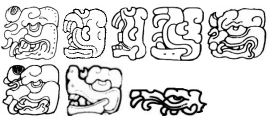




K&H.p81.#3 TOK.p22.r5.c1 BMM9.p15.r5.c1 JM.p58.#2 S&Z.p179.#75
CHAPAT CHAPAHT CHAPAT CHAHPAT CHAPAT



K&L.p20.#1 = KuppratApp Kettunen&Davis-SCSC.p33.tab1.1 Kettunen&Davis-SCSC.p33.tab1.3
CHAPAT CHAPAT cha:CHAPAT:ti

MHD (Looper)
Altar O' / Monument 23 C01-D02
tzi:<ka.<CHAPAAT:HAAB>.ka>
· Do not confuse this with the semantically related wak and kamis, which are two other words for “centipede”.
· The full-figure variant, from Altar O' / Monument 23:
o Shows a human-like body with the head of a centipede, identified by the two characteristic fangs.
o Is quite rare, in this case infixed in the ISIG to match the HAAB-month of the ISIG’s LC.
· The mouth is usually open, but in some cases, it can be closed (when the mouth is closed, it might be confused with the “CHAPAAT-variant” of BAAK).
· Diagnostics to help distinguish it from the “CHAPAAT-variant” of BAAK are:
o CHAPAAT often has a “scroll” within the top part of the head (which BAAK never has).
o CHAPAAT often has a forehead ornament (especially if the mouth is closed) Note: the “CHAPAAT-variant” of BAAK also sometimes has a forehead ornament!
· Do not confuse this with the visually similar (perhaps uncommon variant of) CHAN = “snake” with an open mouth (see CHAN = “snake”).


Kettunen&Davis-SCSC.p33.tab1.2 Kettunen&Davis-SCSC.p33.tab1.4
K1256 Ceramic Vessel
cha.<pa:ti> SAK.<cha:pa:tu>
· Martin-GBoLMotMC.t0:13:00 also gives Kettunen&Davis-SCSC.p33.tab1.2 without giving the source; Martin states that this is the one instance from which we know that the logogram for a centipede is pronounced chapaat, but Kettunen&Davis-SCSC.p33.tab1.4 shows another, and EB.p48..pdfp53 #3 lists cha?-pa-tu > chapat RAZ Tomb 19 Vessel, which is probably the same reference as Kettunen&Davis-SCSC.p33.tab1.4.
· The drift of Martin’s assertion is still important: there are preciously few sources from which we can surmise that the central consonant is ‑p‑; however, Ch’olti’, Ch’orti’, Yucatec and Mopan all have clearly related cognates, with ch‑p‑t (Kettunen&Davis-SCSC.p26-27).